Can a True Parrot (Hoplarchus Psittacus) coexist in the same tank with a Chocolate Cichlid (Hypselecara Temporalis), and maybe a couple of Uaru Amphiacanthoides or is this tank too small?
125 gallon
- Thread starter Cichlidfever
- Start date
You are using an out of date browser. It may not display this or other websites correctly.
You should upgrade or use an alternative browser.
You should upgrade or use an alternative browser.
Uaru and Psittacus get huge. Great growout, but I'd be more comfortable with a wider tank. You may be able to keep a Psittacus pair in there without other cichlids. I believe Psittacus are blackwater species, so hopefully you have soft, acidic water out of the tap- its never fun chasing parameters.
I agree with the above.Uaru and Psittacus get huge. Great growout, but I'd be more comfortable with a wider tank. You may be able to keep a Psittacus pair in there without other cichlids. I believe Psittacus are blackwater species, so hopefully you have soft, acidic water out of the tap- its never fun chasing parameters.
Wonderful grow out, but for any more than one pair as adults, a 125 is a bit wimpy.
Also agree about water parameters, needing to be low pH, and mineral poor, and can add lots of tannins.
If they are not, unless you do almost daily large enough water changes to keep nitrate at undetectable levels, HITH will be a constant battle.
But if your tap water is pH 7 or lower, and water very soft, grow outs, reduced to a pair in about a year, you will be golden.
Agree with the above comments, imo a 125 is overly ambitious for the 3 large species. Meanwhile, H. psittacus don't always play nice with others or, alternately, can be aggressive among themselves; beautiful fish but can be a challenge to get tankmates right. I've seen even the occasional chocolate be temperamental to similar sized fish.
The tendency for we aquarists, who like big round cichlids, is that we often like to have a tank full of them.
But in nature, big round fish often see each other as direct competition for the same resources, such as similar territory, and preferred food (aquatic veggies) and so seldom hang out together.
And in fact vegetarians can be more aggressive about such things than predators.
As juvies their shoals form as self protection, but they lose that "togetherness"ness" as large adults.
You will often see dissimilar types living merrily together, because they instinctually recognize, that lack of competition
In S America you will often find pike cichlids, living copasetically in tandem, with dinner plate shaped cichlids
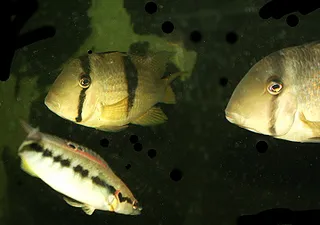
Although because my water parameters have never been conducive to keeping those soft water species, I have gravitated toward their similar dinner plate shaped Central American, hard water counterparts (Vieja and their close cousins), and when I tried communities of them together, at often disastrous results, ensued especially when attempted kept in small to moderate size 6 ft tanks.
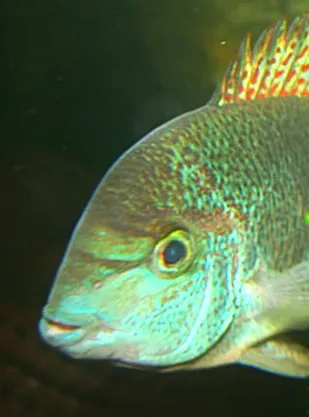
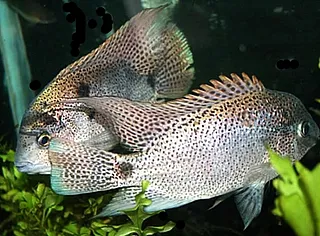
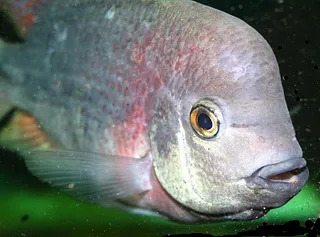
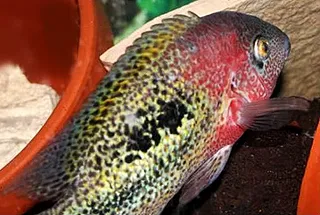
I find tanks in the 125 gal size are usually only sizable enough for a pair of big, flat, cichlids and some dithers, or maybe totally different shaped smaller cichlids.
But in nature, big round fish often see each other as direct competition for the same resources, such as similar territory, and preferred food (aquatic veggies) and so seldom hang out together.
And in fact vegetarians can be more aggressive about such things than predators.
As juvies their shoals form as self protection, but they lose that "togetherness"ness" as large adults.
You will often see dissimilar types living merrily together, because they instinctually recognize, that lack of competition
In S America you will often find pike cichlids, living copasetically in tandem, with dinner plate shaped cichlids

Although because my water parameters have never been conducive to keeping those soft water species, I have gravitated toward their similar dinner plate shaped Central American, hard water counterparts (Vieja and their close cousins), and when I tried communities of them together, at often disastrous results, ensued especially when attempted kept in small to moderate size 6 ft tanks.




I find tanks in the 125 gal size are usually only sizable enough for a pair of big, flat, cichlids and some dithers, or maybe totally different shaped smaller cichlids.
It's a little different with (some) SA species. I've kept Heros in groups (or not) for years. Heros in the wild frequently travel in groups as do Mesonauta, and, of course, so do angels and discus. I've seen a lot of wild underwater video with Heros and Mesonauta, Heros and angels, angels and Mesonauta, etc., and even Heros, Mesonauta, and Hypselecara-- that said, you wouldn't consider them all large fish and it's a different story when a spawning pair finds a protected spot to themselves. What works in the wild doesn't always work in a tank, where tank space, species, and individual fish can all make a difference.
The big difference between South and Central Americans (as far as aggression goes) is that southerners naturally live in very diverse species rich cichlid communities, as opposed to Central America where only a few different species may be found in common in the same space.It's a little different with (some) SA species. I've kept Heros in groups (or not) for years. Heros in the wild frequently travel in groups as do Mesonauta, and, of course, so do angels and discus. I've seen a lot of wild underwater video with Heros and Mesonauta, Heros and angels, angels and Mesonauta, etc., and even Heros, Mesonauta, and Hypselecara-- that said, you wouldn't consider them all large fish and it's a different story when a spawning pair finds a protected spot to themselves. What works in the wild doesn't always work in a tank, where tank space, species, and individual fish can all make a difference.
As stated above, in Amazonia you may find angels, with festivum, with Ceithicara, with severums with pike cichlids, often only restricted by flow preference,, in mile wide rivers. And cichlid to non-cichlid population ratios are higher than in the north.
In Central America the natural habitats are often much more restricted in volume, and where I collect, often only a single species of cichlid is found, and even then, in very restricted numbers, compared to noncichlids.
Collecting, Rio Utive, Panama...Collecting the Rio Mamoni Pleco's...Collecting Rio Campana Panama...Collecting Pedro Miguel (catfish)
Here in Central America, for every 1 cichlid, you may find hundreds of Tetras, or mullet, and 20 to 50 catfish, as opposed to a plethora of diverse cichlid species..
This propensity for communal living for S Americans does not negate the problems that come with crowding them in a puddle though,
it just eases it a bit with communal/shoaling species like Heros, our Geophagus.
Ive only ever seen a pair of truly full grown psittacus once in the flesh and it was truly one of those moments "whoa i didn't know they got that big."
My parrot was like 12+” when I got rid of him and he was very mean to my other SA cichlids. My chocolates were gentle giants and did great with my Severums.


